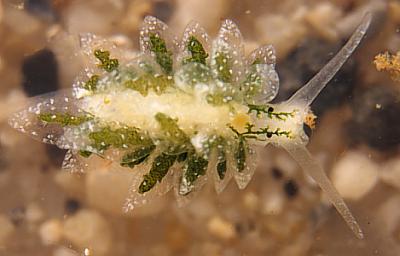
Placida? dendritica?
Polynesian & NW Pacific specimens
Order: SACOGLOSSA
Superfamily: LIMAPONTIOIDEA
Family: Limapontiidae
PHOTO
Moorea, French Polynesia, August 2000. Approx 3mm long. Photo: Daniel Geiger.
Placida dendritica is either a cosmopolitan species or there are a complex of very similar looking species found in various parts of the world. See Kathe Jensen's comments suggesting that there could be three genera on this page.
See also:
• Southeastern Australian specimens.
• North Atlantic specimens.
Rudman, W.B., 2000 (December 18) Placida? dendritica? Polynesian & NW Pacific specimens. [In] Sea Slug Forum. Australian Museum, Sydney. Available from http://www.seaslugforum.net/find/placden2
Related messages
Re: Okinawa Placida sp.?
March 22, 2005
From: Cynthia Trowbridge
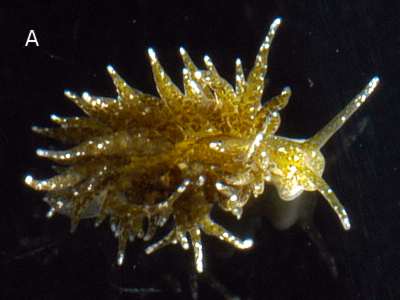
Dear Bill, Kathe, and Bob,
I have been reading messages you wrote several years ago about the problem or challenge of 'Placida dendritica' from Okinawa [#7277, #7329 ].
I have been working with Yoshiaki and Yayoi Hirano and their students (Chiba University) for several years. We have just completed our 6th sacoglossan survey of Okinawa and I venture to comment on some of the 'Placida dendritica' (in the broadest sense) species found in Okinawa.
Locality: west coast of Okinawajima, Okinawa, Japan, East China Sea. Depth: 1 m . Length: several mm (data in Japan). 10-15 March 2005. rocky intertidal or shallow subtidal. Photographer: Tomohiro Watanabe.
I agree with Kathe's statement [#4177] that the French Polynesian 'Placida dendritica' really belong to Ercolania. This species (or a sibling one) is very common in Okinawa but I will present details about it separately.
Next, there are two species (?) of 'Placida' associated with Codium in Okinawa. The first is very, very, very common: we have collected hundreds on Codium intricatum and some on the coexisting C. arabicum. They were on Codium during every one of our 6 trips -- thus, this species appears to be present all year around. The radular teeth are blade-shaped but I have not looked at the reproductive system yet. I have started sequencing the COI gene of this animal. I think that this species may be what Kathe was calling Stiliger / Placida verticillata....? [Photos: A, B ]. I would be eager to hear others' views.
The second form or species (?) is much less common [Photo: C]. We have only collected 2 individuals of this from Codium (March 2005). This animal looks much more like what Baba (1986) called Placida sp. (=Hermaea dendritica). It has shorter rhinophores that flare a bit terminally. It looks much more like the Placida sp. (sensu Baba 1986) that we find in Sagami Bay.
-
Baba K (1986) Anatomical information on Placida sp. = Hermaea dendritica of Baba, 1937 and 1955, from Japan. Shells and Sea Life 18:21-22
Finally, we have yet another Placida species associated with Bryopsis from Okinawa and Izu Peninsula. I will present that species separately.
I would be keen to hear what you think about these sacoglossans.
Cordially,
Cynthia
trowbric@onid.orst.edu
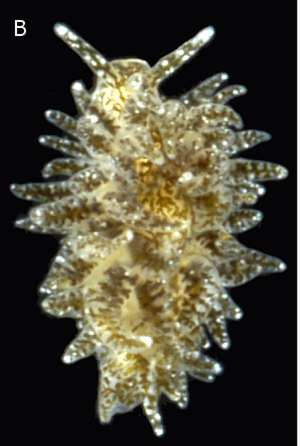
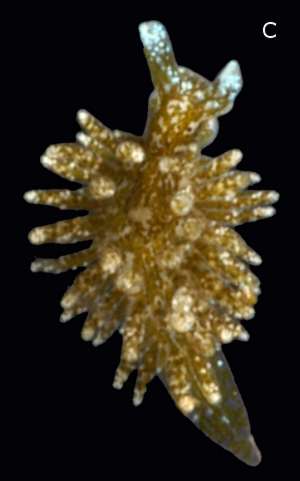
Dear Cynthia,
I think I will leave this for Kathe to comment on
Best wishes,
Bill Rudman
Re: Okinawa Placida sp.
June 21, 2002
From: Kathe R. Jensen
Dear Bill,
I looked at all the pictures on your Placida dendritica Polynesia - NW Pacific Page, and I think we may have 3 genera involved here. Bob Bolland's animal looks most similar to the "real" (European) P. dendritica. I have already commented on the species from French Polynesia, which I think is a species of Ercolania. The species from Taiwan looks rather similar to the amphi-Atlantic Stiliger verticillata (Ortea, 1982). Ortea described it as Placida verticillata from the Canary Islands, but Kerry Clark had collected this species in Florida, and had a description almost completed when Ortea's paper came out, and if I remember right, we had decided that it was a Stiliger based on the reproductive anatomy (no penial stylet is the one character I remember). So we definitely need to look at anatomy - and maybe DNA to sort these out.
Greetings,
Kathe
jensen@ait.ac.th
Jensen, K.R., 2002 (Jun 21) Re: Okinawa Placida sp.. [Message in] Sea Slug Forum. Australian Museum, Sydney. Available from http://www.seaslugforum.net/find/7329Thanks Kathe,
I am glad I didn't try and identify them.
Cheers,
Bill
Okinawa Placida sp.
June 20, 2002
From: Bob Bolland
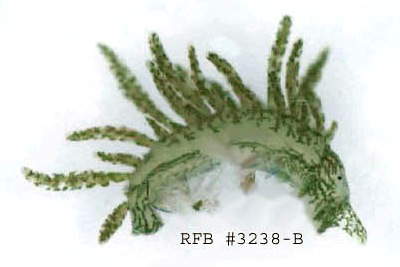
Hi Bill,
Here's a relatively poor scan of a damaged Placida sp. (P. dendritica?) from here on Okinawa. Any idea as to what it may be? It wasn't found associated with any specific alga.
Data:
RFB # 3238-B
TL: approx. 5mm
From 12 meters
Seragaki, Okinawa
15 Apr 1994
Cheers,
Bob
bollandr@rapid-link.ne.jp
Bolland, B., 2002 (Jun 20) Okinawa Placida sp.. [Message in] Sea Slug Forum. Australian Museum, Sydney. Available from http://www.seaslugforum.net/find/7277Thanks Bob,
Perhaps Kathe can say something, but in the meantime I will put it on the Polynesia - NW Pacific page for Placida dendritica look-alikes. I am not sure if I am interpreting your photo correctly but the rhinophores seem to be rolled (or folded) in your animal, which is different from the others on this page which have a simple tapering rod-like rhinophore - and would suggest another genus.
Cheers,
Bill Rudman
Re: Placida dendritica (?) from French Polynesia
February 16, 2002
From: Kathe R. Jensen
Dear Bill,
Erwin Koehler sent me a message about this species, which you tentatively identified as Placida dendritica. I remember seeing it - and shoving it to the back of my memory (where things tend to get lost nowadays!). However, I think that this is more likely a species of Ercolania. There are a number of reasons for this: The cerata appear inflated, and the digestive gland tubules do not have conspicuous side-branches. Also, there is a large white area middorsally, corresponding to the reno-pericardial ridge, where Placida dendritica usually has a network of digestive gland tubules. Also, the rhinophores appear to be "simple" or slightly flattened at the bases, whereas P. dendritica has folded or deeply grooved rhinophores containing branches of the digestive gland. I do not not dare to put a species name on this one. It seems similar to Ercolania translucens, which I described from Rottnest Island (Western Australia) some years ago, but it also has a certain resemblance to a juvenile E. coerulea, which lives on Dictyosphaerea or Valonia, and the last time I visited Rottnest Island, I found a few specimens of what I think is an undescribed species of Ercolania, which I think occurred on Struvea and Cladophoropsis, and which had a purple "spot" (probably the genital receptacle visible through the epidermis) in the neck. The only way to find out whether this is Ercolania or Placida (or even Stiliger) is to look at its radular teeth, which are blade-shaped in Placida (and Stiliger - which does not have a penial stylet), and "sabot-shaped" in Ercolania. Ercolania and Placida both have short, curved penial stylets (very short and pointed in E. coerulea).
Cheers,
Kathe
jensen@ait.ac.th
Jensen, K.R., 2002 (Feb 16) Re: Placida dendritica (?) from French Polynesia. [Message in] Sea Slug Forum. Australian Museum, Sydney. Available from http://www.seaslugforum.net/find/4177Thanks Kathe,
I'll just call it Placida? dendritica? for the time being.
Bill Rudman
Placida dendritica (?) from French Polynesia
December 20, 2000
From: Daniel L. Geiger

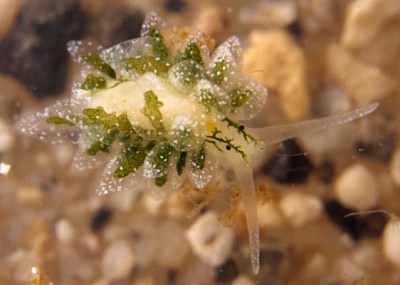
Hi everybody,
Two specimens of this species were collected on Seagrass in Moorea, French Polynesia in August 2000. The specimens are approximately 3 mm long. I tentatively ID-ed it as Hermaea/Placida dendritica. Any opinion?
[Details: 4523 Placida / Hermea sp. French Polynesia, Moorea, VIII 2000. Provia 100F, 28mm, AZ, 2x T32, approx. 6:1, dorsal. Found on Seagrass by Oxford crew. Specimen in LACM collection.]
Best wishes
Daniel
dgeiger@nhm.org
Geiger, D.L., 2000 (Dec 20) Placida dendritica (?) from French Polynesia. [Message in] Sea Slug Forum. Australian Museum, Sydney. Available from http://www.seaslugforum.net/find/3303Thanks Daniel,
Another interesting animal for Cynthia Trowbridge to look at
Bill Rudman.
Placida dendritica? from Taiwan
March 11, 2000
From: Jui-Sheng Chang
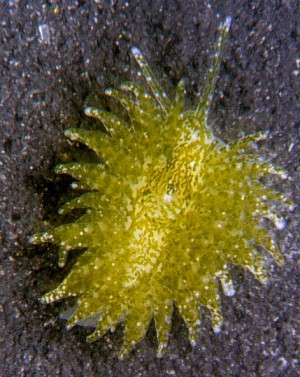
Note: this is part of a separate message dealing also with a species of Stiliger
Dear Dr. Rudman:
I am Jui-Sheng Chang, a student in National Taiwan University. I am studying the Codium blooming on coral reef in southern Taiwan. I have found two kinds of sea slugs which are living with Codium edule. But I do not know what the species names are....The length of both unknown species is only about 0.5 cm. They can feed with Codium edule and lay eggs on the Codium branches.
Thank you so much for looking my questions.
Your Sincerely
Jui-Sheng Chang
d5241003@ms.cc.ntu.edu.tw
Chang, J-S., 2000 (Mar 11) Placida dendritica? from Taiwan. [Message in] Sea Slug Forum. Australian Museum, Sydney. Available from http://www.seaslugforum.net/find/7315Dear Jui-Sheng Chang,
This is of a species I am tentatively calling Placida dendritica but as you will see if you read the messages on that page, the general feeling is that there are a complex of similar looking species worldwide which will need sorting out. The ramifying green pattern you can see are ducts of the digestive gland containing green chloroplasts from Codium which it probably keeps alive in its body. See the page on Solar powered slugs for information on how these animals utilise the chloroplasts.
est wishes,
Bill Rudman.
